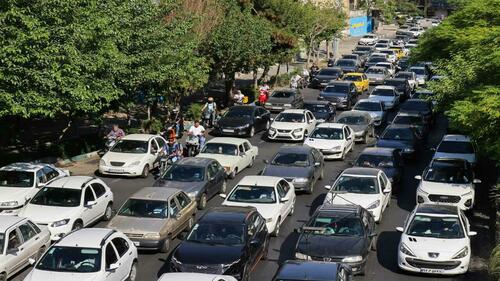
Early Signs The Iran War Is Triggering Another Mideast Refugee Crisis
The United Nations has warned that the Iran-Israel war could trigger a new refugee crisis in the Middle East, saying that if things keep escalating and people flea, there is no quick way back to their home countries.
UNHCR, the UN’s refugee agency, says ratcheting tit-for-tat attacks are already triggering population movements in both countries, and that this could easily slide into a worse crisis.
 Traffic jab as people attempt to get out of Iranian capital area, AFP.
Traffic jab as people attempt to get out of Iranian capital area, AFP.Iran has already seen many of its citizens cross into other countries, at a moment much of Tehran’s streets have remained largely empty on fear of Israeli warplanes, which have control of skies over Western Iran.
And Iranian ballistic and hypersonic missile attacks on Israel have caused people to seek a way out of the country, whether air, sea, or land borders.
„This region has already endured more than its share of war, loss and displacement. We cannot allow another refugee crisis to take root,” says Filippo Grandi, the UN high commissioner for refugees, in a statement issued Saturday.
„The time to de-escalate is right now. Once people are forced to flee, there’s no quick way back — and all too often, the consequences last for generations,” Grandi added.
According to more from the newly published UN statement:
As highlighted in our Global Trends 2024 Report last week, Iran is the largest refugee-hosting country in the world with some 3.5 million refugees, mainly from Afghanistan. If the conflict persists, existing refugee populations would also face renewed uncertainty and yet more hardship.
UNHCR is present in Iran, Israel and many neighboring countries, and is arranging emergency humanitarian relief supplies in different locations, readying a response in case needed.
This fact of such a large Afghan refugee population inside Iran is cause for deep concern, amid fears that the 2015 European crisis could be repeated.
At that time, the Syria proxy war was at its height of death and destruction, and the Libyan government had a few years prior been overthrown. Still, US and European officials don’t tend to do much self-reflecting on how their regime change policies in the Middle East have largely created wave after wave of refugees inbound for Europe.
Images showing bumper-to-bumper traffic out of Tehran has widely circulated this week:
The leaders of Iran didn’t listen to Trump, but the people of Tehran are. Bumper to bumper traffic of people leaving. pic.twitter.com/pXbnT0SBmw
— Paratrooper Brady (@ParatooperBrady) June 17, 2025
The Economist says that to some extent, it’s already happening:
Thousands of terrified people are fleeing Tehran and other cities that are under attack, turning them into ghost towns. With airports closed, the only exits are by road. Social-media posts show vast traffic jams. Neighboring countries are considering how they might respond if the outflow of people spills across Iran’s borders. Many remember the crisis caused by Syria’s civil war, which saw 6m refugees leave. So far the exodus from Iran has been tiny, but that could change.
Large movements of people are currently focused on seeking at Iran’s northern border:
Many of those fleeing Tehran are heading north, to the less urbanized areas near the Caspian Sea, some 100km away. Even that journey is arduous. The roads are clogged and petrol is scarce, reflecting panic buying and, perhaps, Israeli strikes on oil facilities. Mobile signals are no longer reliable. One person outside the country says it has taken his family inside it more than 12 hours, instead of the normal four, to get to the mountainous Gilian area by the coast. He says that as they drove they saw “artillery in the sky and fires in the background”. Their plan is to stay in the country. “They do not want to leave Iran, it is home for them.”
Should the Israel-Iran conflict worsen, the war could spread to Iraq – where militias aligned to Tehran are predominate. They’ve warned that if the US gets involved, American forces at regional bases could come under retaliatory attack.
Tyler Durden
Sat, 06/21/2025 – 11:05
















